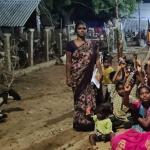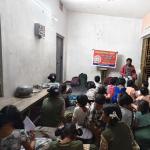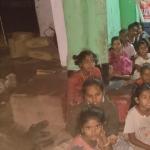[GHHF] Students learned about Lala Lajpat Rai, who was called Lion of Punjab, Indian revolutionary, and organized Peaceful protests
 Lala Lajpati Rai was born on January 28, 1865 and died on November 17, 1928. He was a keen student from his childhood. Although his father was a teacher, he was attracted to the teachings of Arya Samaj, especially the national outlook it preached. Although he established himself as a great leader, he founded the 'Servants of People's Society' for social service.
Lala Lajpati Rai was born on January 28, 1865 and died on November 17, 1928. He was a keen student from his childhood. Although his father was a teacher, he was attracted to the teachings of Arya Samaj, especially the national outlook it preached. Although he established himself as a great leader, he founded the 'Servants of People's Society' for social service.
Multifaceted Talent – Reform, Swadeshi: Lalaji was not just a politician, but a great intellectual, writer, reformer and a builder of charitable works.
Reform: During the famine, he started the Hindu Relief Movement to save helpless Indians from the clutches of the Kestava missionaries.
Swadeshi & Education: He played a key role in the Swadeshi movement during the Bengal Partition Movement. He founded the National College in Lahore, where Bhagat Singh studied.
Vision: He foresaw the historical issue of the partition of India that took place in the later period and guided the leaders of that time.
The roar of the Punjab lion – a miraculous martyrdom: Lalaji became famous as one of the Lal-Bal-Pal trio.
In 1928, a peaceful protest was held in Lahore against the Simon Commission, which was ordered by the British government. The Superintendent of Police James A. Socket ordered the lathicharge on the silent protesters. The lathicharge on Lalaji's chest was very severe.
Lalaji, who was ready to die with his wounds, made this great statement as a visionary: "Today, the lathicharge on my heart will be the last nail in the coffin of British society. I may die, but from every drop of blood that flows from me, millions of freedom fighters will emerge".
This is true. He died on 17 November 1928 due to serious injuries. After his death, the freedom movement spread further. His call touched the hearts of the people of the country and intensified the struggle of heroes like Bhagat Singh and Chandrashekhar Azad. The freedom of this country is the result of the struggle and sacrifice of all these heroes.
Humanism: He was primarily a humanist. "If I had the power to rule the Indian newspapers, I would say that these three headlines should be on the front page: Milk for the children, food for the elders, and education for all," he said. Lalaji's life is a strong answer to the question of whether it is possible for extraordinary things to emerge from ordinary families.
Teacher Tasks
Discussion after the story: (Analysis)
How did Lalaji's life prove that it is possible for 'commoners to become commoners'? (Diligence in studying, selfless service, Standing for ideals.)
How did Lalaji earn the title 'Punjab Kesari'? (Courage, leadership.)
What was the message of Lalaji's last words? (His martyrdom is said to be the beginning of the end of British rule. Discussion on the issue of working towards solving cultural problems with the image of freedom fighters.)
Expression of emotions (Creativity)
Humanitarian poster: Lalaji's humanitarian point of view should be illustrated by drawing a poster with the slogan "Milk for children, food for adults, education for all" with dolls or letters.
Future vision: Children should recite the phrase "From every drop of blood that emanates from me, millions of freedom fighters will emerge"together.
Practical Action (Implementation)
Social Responsibility: In the spirit of Lalaji, this week, think about a social problem around you (e.g. lack of sanitation, lack of access to healthcare) and make a small effort to solve it.
Selfless Service: Like Lalaji, who gave up profit for social service, this week, selflessly help others.
Your donations are appreciated.
By Zelle: ghhfusaorg@gmail.com
PayPal: savetemples.org
By Check: Or you can send a check payable to GHHF, 14726 Harmony Lane, Frisco, TX 75035.
It is tax-deductible.
By Rupees: call 601-918-7111; +91 83096 43979




















 Urgent support needed for Bangladesh Hindus
Urgent support needed for Bangladesh Hindus 







